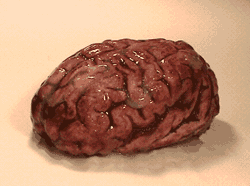By now, everyone has read about the so-called "homosexual" (actually bisexual) fruit flies (Grosjean et al., 2007):1
Study finds gay gene in fruit fliesIt's not surprising that the popular press used tabloid terminology to sell the story. But how many of you have seen the highly critical News and Views article by Joel D. Levine in the January 2008 issue of Nature Neuroscience? He calls Grosjean et al. on the carpet for using sensationalistic language, which the editors and reviewers apparently allowed into the final version of the manuscript.
SUMMARY: Scientists have found that a gene can turn on and off homosexual impulses in fruit flies.
Researchers in Chicago have discovered a gene that identifies homosexuality in fruit flies, which can be turned on and off with drugs. David Featherstone, a biologist at the University of Illinois, said that while humans have a similar gene, it has yet to be determined whether that gene has any effect on same-sex attractions in humans.
Glia and romanceYou have to give the editors some credit, though, for publishing Levine's critique, although it would've been more fun if they let flyingkumquat write the rejoinder instead:
Drosophila courtship is a complex behavior. A new study shows that glia modulate neurotransmission to influence male preference, but the authors should have resisted the temptation to describe their results in tabloid language.
...In the current issue, Grosjean et al. describe an unexpected role for glial cells in the initiation of male courtship behavior. A mutation that reduces expression of a glial amino-acid transporter causes male flies to court other males with the same probability as females. The authors accordingly named this transporter genderblind. The courtship behavior associated with the genderblind mutation is certainly different from control behavior, but is it really homosexual?
. . .
The study by Grosjean et al. makes an important contribution by calling attention to a neuro-glial element in the circuitry that governs courtship behavior. Furthermore, this study initiates the search for the glutamatergic neurons involved in the processing of courtship pheromones.
Apart from its merits, however, this paper has a serious language problem. Throughout, the authors use the term homosexual to describe the behavior of a male mutant that courts both males and females with equal probability. If anything, these flies might be bisexual, but the data are also consistent with the possibility that genderblind mutants would court anything painted with 7-tricosene...
. . .
...bizarre misapplication of fruit fly research spilling into the public and political arena may well be fostered by scientists' increased use of tabloid language. Yes, the business of science requires communicating effectively, raising money, and indeed a form of advertising, but the language in scientific papers must stick to the facts. My argument is not at all about political correctness. The misuse of a term like homosexual in this and other cases is simply inaccurate, unnecessary, and, in the end, bad for the scientific business.
I have had enough of the "OMG You Can Turn Fruit Flies Gay and Then Straight Again" silliness.
Some fishes can change their sex. I don't see people saying, "OMG Fishes Can Change Their Sex, Maybe We Can Too!"
Perhaps a new section of the journal can be called Dish and Bitch...
Footnote
1 For an excellent summary of courtship in the genderblind mutant, see Bisexual flies and the neurochemistry of behavior. See also Wait for it...Wait for it...It's Teh Gay Gene!
References
Grosjean Y, Grillet M, Augustin H, Ferveur J-F, Featherstone DE. (2007). A glial amino-acid transporter controls synapse strength and
Levine JD (2008). Glia and romance. Nature Neurosci. 11:8-10.



























